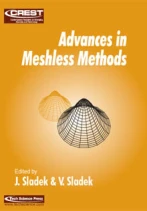Oncology Research Is Now Indexed in the Open Access Journal Index (OAJ)
Structural Durability & Health Monitoring Recognized as an ANVUR Scientific Journal
Tech Science Press Representative Featured in SSP Professional Profiles Series
International Journal of Mental Health Promotion Recognized as ANVUR Scientific Journal

Edited by: J. Sladek & V. Sladek
Meshless methods belong to one of the most progressively developed part of the computational mechanics. These methods are increasingly applied to many fields of engineering and sciences. Therefore, the number of new results in this field is growing
The development of approximate methods for the numerical solutions of boundary value problems has attracted the attention of engineers, physicists and mathematicians for a long time. The finite element method (FEM), for the modelling of complex problems in applied mechanics and related fields, is well established. It is a robust and thoroughly developed technique, but it is not without its own shortcomings. It is well-known that the FEM method relies on a mesh discretization, which leads to complications for certain classes of problems. The loss of accuracy is observed when the elements in the mesh become extremely skewed or distorted. The boundary element method (BEM) has become an efficient and popular alternative to the FEM, especially for stress concentration problems, or for boundary value problems wherein a part of the boundary extends to infinity. In spite of the great success of the finite and boundary element methods as the most effective numerical tools for the solution of boundary value problems in complex domains, there has been a growing interest in the so-called meshless methods over the past decade. A number of methods has been proposed so far including the smooth particle hydrodynamics (SPH) method, the diffuse element method (DEM), the element free Galerkin (EFG) method, the reproducing kernel particle method (RKPM), the moving least-squares reproducing kernel (MLSRK) method, the partition of unity finite element method (PUFEM), the hp-clouds method, the finite point method, the meshless local Petrov-Galerkin (MLPG) method, boundary node method (BNM), the local boundary integral equation (LBIE) method, and the method of finite spheres (which is a special case of the MLPG method, when the local sub-domains are chosen to be spheres in 3-D). Meshless methods originated from the work on finite difference (FD), finite element (FE) and boundary element (BE) methods, but meshless methods can treat an irregular distribution of points and require no costly mesh generation. In addition, since meshless methods use a functional basis and allow arbitrary placement of points, the solution and its derivatives may be found directly where they are needed and with greater accuracy than with FD, FE and BE methods where differences and interpolation are required. The term “meshless” or “meshfree” stems from the ability of an approximation or interpolation scheme to be constructed entirely from a set of nodes. The automatic generation of good quality meshes required in conventional computational methods presents significant difficulties in the analysis of engineering systems. These difficulties are circumvented when no mesh is needed. Therefore, meshless methods are very convenient to analyze crack propagation problems and other problems with free surface movement as well as large deformation processes where remeshing at each step of the problem becomes prohibitively expensive in conventional approaches.
Some of the above mentioned meshless methods, namely the RKPM, SPH method, DEM and EFG method, are not truly meshless. All these “pseudo meshless” methods use integration cells. Only finite point method, the MLPG (and its special variation, the so-called method of finite spheres), and LBIE are truly meshless. However, although considerable efforts have been made in the development of meshless methods, the currently available techniques are still computationally much less efficient than the well established conventional discretization procedures. The primary reason is that non-polynomial shape functions are employed and the required numerical integration is very difficult to perform accurately.
Meshless methods belong to one of the most progressively developed part of the computational mechanics. These methods are increasingly applied to many fields of engineering and sciences. Therefore, the number of new results in this field is growing significantly during the past few years. It is a natural need to organize a conference in this subject to discuss about further developments of meshless methods. The first ICCES meshless symposium held in High Tatras, Slovakia brought together both mathematicians and engineers interested in developing new progressive computational methods. The best selected lectures from the symposium are collected in this book in their extended form.
Hardcover. 320 pages. © 2006. ISBN: 0-9717880-2-2.